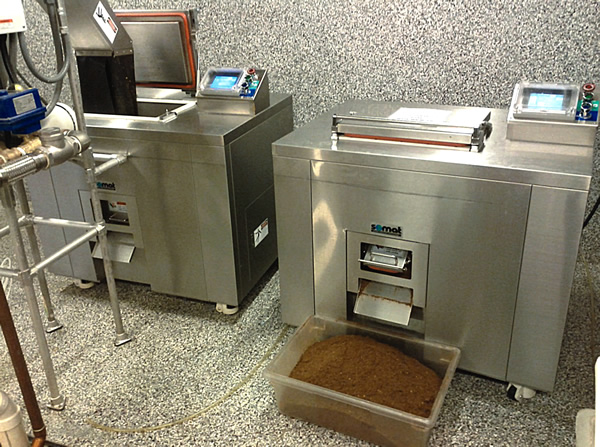Interviews conducted with representatives of corporate facilities, a university, a hotel and a hospital indicate success with these systems in their particular settings. Part II
Zoë Neale
BioCycle January 2014
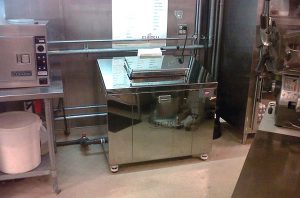
The Power Knot biodigester at the Fujitsu campus in Sunnyvale, California processes about 500 lbs/week of food waste from the prep area in an on-site cafeteria.
Part II highlights case studies and some of the lessons learned from several sites that utilize these approaches. The reader should bear in mind while reading the following case studies that these were submitted to the author from the manufacturers and/or distributors themselves, leading to a “self-selected” group of interviewees. This article should not be interpreted as an endorsement by BioCycle or the author for any technology or specific approach profiled below.
Some of the key user comments regarding considerations that influenced their purchasing decisions were:
1. Dehydrators can tolerate soiled paper, waxed cardboard and napkins; biodigesters cannot.
2. Biodigesters require significantly higher amounts of water than dehydrators.
3. Dehydrators use more electricity than biodigesters.
4. Most dehydrators are batch systems; biodigesters are continuous.
5. Biodigesters are more prone to effluent composition issues related to biochemical oxygen demand (BOD) versus dehydrators, where the effluent is primarily reconstituted steam. BOD is a measure of how much organic material is in the discharge liquid and, if too high, can deplete the oxygen level of where it is being discharged.
6. Some dehydrators are designed to be coupled with pulpers as a pretreatment step, which can benefit the consistency of the end product.
7. Both technologies represent a labor savings versus the traditional separate, collect and haul model for organics diversion.
Case Studies
Fujitsu, Sunnyvale, California: Power Knot’s “Liquid Food Composter” (LFC) was installed two years ago at a large Fujitsu campus in Sunnyvale. The campus is comprised of seven buildings with a total of 450,000 sq. ft. of space that houses office workers (no manufacturing) and approximately 800 to 900 employees. The LFC biodigester is located within the prep area of Fujitsu’s on-site cafeteria, which serves 150 to 200 meals a day and generates approximately 100 pounds (lbs)/day (500 lbs/week) of back of the house (kitchen prep) food waste. Robert Curtis, Fujitsu’s Environmental, Health, Safety & Security Services Specialist, had the biodigester installed two years ago after seeing the machine at a real estate facilities conference. He was attracted to the approach due to the perceived environmental and economic benefits of dealing directly with the company’s organic waste on-site rather versus the previous approach of commingling it with the mixed trash. Curtis stated that the payback on the $18,000 machine was 18 to 20 months — a result of reduced trash pick up, which went from every day to three times a week. He appreciates the continuous feed aspect of the machine as a way of not having to “store up” the food waste, which he feels would be a challenge at this location.
When the LFC was installed, no permit was required or obtained from the city of Sunnyvale. Curtis submitted Power Knot’s effluent study to the city and the pH was within the acceptable range. No other characteristics of the effluent (i.e. BOD, total suspended solids (TSS), etc.) were commented on by the city although an effluent study conducted at Fujitsu by PowerKnot showed BOD of 320 ppm. Plumbing was installed to direct the effluent to the drain. The unit needed to be taken out of service once in the two years since its installation because lemon grass was put in, which took too long to be digested. The LFC needed to be shut down, cleaned out and restarted.
Although Power Knot recommends that its biologic agent be added twice a year, Fujitsu has only needed to add it once a year due to the facility’s relatively low volume of food waste. Curtis mentioned an interest in recapturing the effluent for use directly on the buildings’ lawns (PowerKnot has told him that the effluent can be directly applied to landscaping), however there are too many logistical hurdles to implement that program.
Rand Whitney Recycling, Montville, Connecticut: Pamela Retseck, Project Manager for Rand Whitney Recycling, has worked with Gaia equipment for over four years as part of large scale recycling projects that involve organics diversion. A large government contractor in New England had been separating organics for composting, As the facility is very large — 7,500 people with four cafes and three shifts — there was a substantial amount of food waste that was being stored on a loading dock contiguous to the main kitchen. The source separated organics were being picked up three times a week. It is quite warm on the loading dock, which is internal, and the site was experiencing several vector problems, including mice and a severe fruit fly infestation. The fruit fly issue was noticeable within one of the large cafes, which needed to be rectified.
To address these issues, Rand Whitney installed a Gaia 100 dehydrator. The machine has functioned well mechanically, with a high level of service and support from Gaia, noted Retseck. Benefits included eliminated the cost of organics collection, which required extra security to accompany the trucks in and out of the facility, and use of the dehydrated food waste as part of a mulch and compost mix (it represents about 1% of the mix. This option is only possible due to the substantial landscaping at the facility.
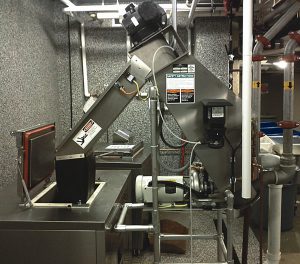
St. Cloud Hospital, a 489-bed acute care facility in St. Cloud, Minnesota, serves an average of 900 patients three meals a day, along with preparing food for other dining operations. A pulper was installed, along with two Somat dehydration units (wet pulp being deposited into a dehydrator is shown).
Boston Marriott Quincy, Boston, Massachusetts: The Boston Marriott Quincy is a large, multifunctional facility located approximately 10 miles south of downtown Boston. The hotel has nine floors, 464 guest rooms offering room service from 6:00 am to 11:00 pm, 10 meeting rooms covering over 15,000 sq. ft. of space and two full service restaurants. The Marriott serves anywhere from 300 to 1,200 meals daily, which generates an average of approximately 800 pounds per day of food waste. The Chief Engineer at the hotel, Matthew Murray, made the decision two years ago to install a BioHitech America biodigester after a solicitation by a sales representative. For several years prior to installation of the on-site unit, the hotel had been source separating and storing food waste in toters that were picked up by a local hauler six times a week for diversion to composting. The cost savings from discontinuing this service, not needing to purchase biodegradable bags, the reduction in frequency of dumpster pulls and the ease of not having to stage the organics while waiting for removal have added up to both financial savings and logistical simplicity, according to Murray.
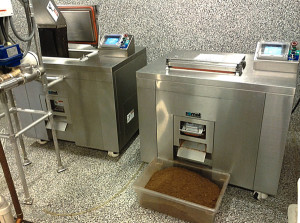
One dehydrator is being filled (on left), while the second has finished the drying cycle and is unloading (above).
St. Cloud Hospital, St. Cloud, Minnesota: St. Cloud Hospital is a 489-bed acute care hospital located on the headwaters of the Mississippi River in St. Cloud. The facility serves an average of 900 patients three meals a day, has a large cafeteria, three bistros and also provides catering service to other, outside buildings associated with the hospital. Originally, the kitchen had been grinding the organic waste and sending it directly to the sewer. Multiple fines were being levied on the hospital by the City of St. Cloud’s water and sewer authority due to high levels of hydrogen sulfide, phosphorus and mercury in its sewer discharge (which the facility managers attributed to food service operations). This led St. Cloud Hospital to start source separating its food waste for diversion to a local pig farmer. Because the volume of organic waste generated by the hospital is quite high (about 1,800 lbs/day), problems arose with the farmer’s variable pick up schedule.
Ultimately, Kathy Frenn, the director of nutrition for CentraCare, a contracted food service provider, had a pulper and two Somat dehydrators installed in June 2012. The impact on the amount of food waste to be managed was dramatic — from 1,800 lbs/day to one 30-gallon receptacle a week. The residual is collected, mixed with soil (40% soil, 60% dehydrated food) and used directly on the grounds of the hospital with no issues such as fungus, which have been found in warmer locations. Overall, the system has solved the effluent issues, and eliminated the need to haul wet food waste around the hospital to the loading dock.
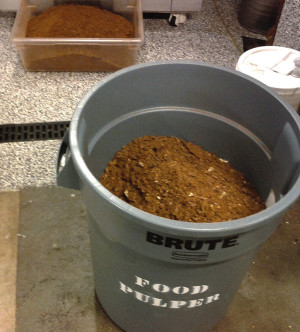
The dry pulp is mixed with soil and used directly on the grounds of the hospital. Photos courtesy of St. Cloud Hospital
Takeaways
In summary, dehydrators and biodigesters are being used in a variety of venues that generate food waste and are chosen for reasons that range from sustainability to cost to vector control. The regulatory environment continues to evolve as wastewater officials gather more data about new sources of effluent into their systems. Although biodigester manufacturers claim a high degree of pretreatment as part of their systems, there is a growing perception from the regulators that these systems are “flying under the radar.” Increasingly, wastewater enforcement officials interviewed believe that biodigesters should be looked at in a similar light as commercial pulpers (that discharge directly to sewers), which are not favored by many wastewater districts due to concerns about hydrogen sulfide buildup and slugs in the pipes, and total solids and BOD content. Several takeaways from interviews for this article series include:
1. Check with local and regional wastewater authorities and sewer commissions to ensure that installation of any system that discharges effluent into the sanitary sewer system adheres to both code and guidance prior to installation. Requirements for effluent composition vary significantly.
2. Check the plumbing code to ensure compliance with local and state regulations.
3. If possible, pilot systems that represent an entirely new approach to organics diversion and processing.
4. Make sure when transitioning to either a biodigester or dehydrator solution to have a solid backup plan if/when the primary equipment is out of service for maintenance. Lack of contingency planning can lead to rapid accumulation of organics that become unmanageable very quickly.
Zoë Neale has spent the bulk of her career as an equity mutual fund manager and advocate for socially responsible investment. She currently works as a business consultant and is a founder and director of Save That Stuff Organics, an organics solutions affiliate of Save That Stuff Inc. Zoë is Treasurer of MassRecycle and chairs the Organics Committee for that organization.


